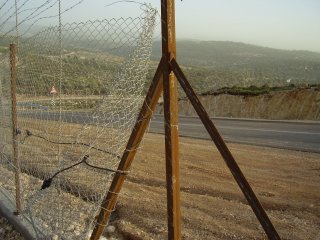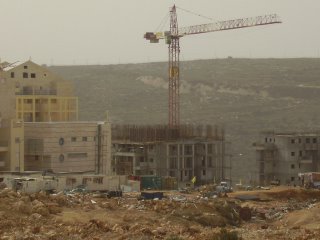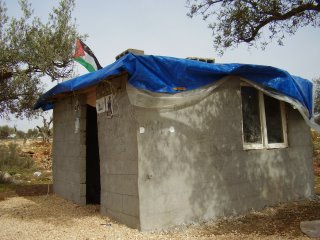Thursday, January 26, 2006
Bil'lin Outpost resisting the occupation
I went with the ISM to the town of Bil'lin two days before the Palestinian Election. As the election was constantly changing and I felt the need to keep up to date with what was going on I am only able to write about my experience now. This is in no way a reflection of priority. The elections were a significant event however the continuing struggle of the Palestinian resistance I'd say is more important.
I had first heard about Bil'lin in Australia. It was and is the base for many anti-wall demonstrations. The fence covers a security road near the town of Bil'lin and cuts the town off from much of its land. Whilst the wall is not made of large slabs of concrete (yet) it contains sensors throughout that are designed to detect any attempt to get through. The gap in the fence that you can see (pictured below) is the result of peaceful demonstration against the wall. Anti-wall demonstrations are now happening weekly the last being about 2,000 people strong (the largest yet).


Even if we were to go around the fence (rather then take a shortcut through the hole) we would only have to travel 50 meters. The fence isn't being built due to a court order that the people of Bil'lin were able to get against the wall. They also don't want to enrage the locals who's resistance is growing.
On the land that looks like being cut off from town Israel's plans seemed clear. 5 large settlements with a total of 100,00 people and growing- keep in mind that Jerusalem only has 600,000 people and the whole of Palestine is about 3-4 million. One of the largest settlements (Modi'en Illit) had 29,300 people in it late last year. 12.7% more then in 2004. The settlements are growing as can be seen in the photo of construction below. Many of the locals predict that one day there will only be one big settlement. These settlements that confiscate Palestinian land are not only exclusively Jewish but also exclusively orthodox. The housing in these settlements costs about half of what you would pay in Jerusalem or a major Israeli city and according to local activists the settlers pay no tax.
Not so far away from these amazingly large settlements stood a slightly more modest but none the less impressive little brick room. This room referred to as the outpost is permanently staffed by the local community and members of the ISM.

 The significance of this building was explained to me by local shepherd and anti-occupation activist Wagi Brnat (who I think looks strangely like Xanana Gusmao) . Apparently not too long ago the villagers brought out a caravan and parked it on the hill opposite the settlements. The Israeli army confiscated the caravan so the village brought another one. The soldiers asked "why is it that you have brought another caravan to this spot. You aren't allowed a caravan here this is government land. We are going to have to remove this one."
The significance of this building was explained to me by local shepherd and anti-occupation activist Wagi Brnat (who I think looks strangely like Xanana Gusmao) . Apparently not too long ago the villagers brought out a caravan and parked it on the hill opposite the settlements. The Israeli army confiscated the caravan so the village brought another one. The soldiers asked "why is it that you have brought another caravan to this spot. You aren't allowed a caravan here this is government land. We are going to have to remove this one."
Brnat (pictured above: right with ISMer's Asha Ashkar back and David Kreuer front) said they asked why the soldiers have not taken the settlements. The soldiers responded by saying the could not remove the settlements because they were constructed already. The army then left saying that if the caravan was still there in 24 hours it would be removed. So the whole community got together and constructed the outpost so by the soldiers logic it could not be removed.
It was raining that day but the community persisted in building this room. When the soldiers the next day to remove the caravan. They saw the structure and were upset. Israel will now have trouble destroying the outpost when even by Israeli law these settlements are illegal.
I stayed overnight in this one room with many members of ISM and the community. The settlement literally obstructs everyday life. We struggled to get water as the ground water can only be accessed by the settlements not the locals. We also had lunch delayed by several hours as the people supplying us with food had to wait for Israeli soldiers to leave before they could cross the illegal road on Palestinian land.
I was asked by Brnat as to why I was here. He thanked me for my solidarity and he said that "if they weren't facing occupation and Australia was that he would help liberate Australia." I then discussed with him the situation facing Indigenous people here in Australia. We talked about colonialism and occupation. He said "I am sorry that I was not around 200 years ago to help the people of Australia resist the occupation and that I have my own occupation here." I told him about the tent embassy in Canberra and how like the outpost it was a symbol of resistance that was under constant threat of being removed. I look forward to seeing the next demonstration which is taking place tomorrow.
Harry
I had first heard about Bil'lin in Australia. It was and is the base for many anti-wall demonstrations. The fence covers a security road near the town of Bil'lin and cuts the town off from much of its land. Whilst the wall is not made of large slabs of concrete (yet) it contains sensors throughout that are designed to detect any attempt to get through. The gap in the fence that you can see (pictured below) is the result of peaceful demonstration against the wall. Anti-wall demonstrations are now happening weekly the last being about 2,000 people strong (the largest yet).


Even if we were to go around the fence (rather then take a shortcut through the hole) we would only have to travel 50 meters. The fence isn't being built due to a court order that the people of Bil'lin were able to get against the wall. They also don't want to enrage the locals who's resistance is growing.
On the land that looks like being cut off from town Israel's plans seemed clear. 5 large settlements with a total of 100,00 people and growing- keep in mind that Jerusalem only has 600,000 people and the whole of Palestine is about 3-4 million. One of the largest settlements (Modi'en Illit) had 29,300 people in it late last year. 12.7% more then in 2004. The settlements are growing as can be seen in the photo of construction below. Many of the locals predict that one day there will only be one big settlement. These settlements that confiscate Palestinian land are not only exclusively Jewish but also exclusively orthodox. The housing in these settlements costs about half of what you would pay in Jerusalem or a major Israeli city and according to local activists the settlers pay no tax.

Not so far away from these amazingly large settlements stood a slightly more modest but none the less impressive little brick room. This room referred to as the outpost is permanently staffed by the local community and members of the ISM.

 The significance of this building was explained to me by local shepherd and anti-occupation activist Wagi Brnat (who I think looks strangely like Xanana Gusmao) . Apparently not too long ago the villagers brought out a caravan and parked it on the hill opposite the settlements. The Israeli army confiscated the caravan so the village brought another one. The soldiers asked "why is it that you have brought another caravan to this spot. You aren't allowed a caravan here this is government land. We are going to have to remove this one."
The significance of this building was explained to me by local shepherd and anti-occupation activist Wagi Brnat (who I think looks strangely like Xanana Gusmao) . Apparently not too long ago the villagers brought out a caravan and parked it on the hill opposite the settlements. The Israeli army confiscated the caravan so the village brought another one. The soldiers asked "why is it that you have brought another caravan to this spot. You aren't allowed a caravan here this is government land. We are going to have to remove this one."Brnat (pictured above: right with ISMer's Asha Ashkar back and David Kreuer front) said they asked why the soldiers have not taken the settlements. The soldiers responded by saying the could not remove the settlements because they were constructed already. The army then left saying that if the caravan was still there in 24 hours it would be removed. So the whole community got together and constructed the outpost so by the soldiers logic it could not be removed.
It was raining that day but the community persisted in building this room. When the soldiers the next day to remove the caravan. They saw the structure and were upset. Israel will now have trouble destroying the outpost when even by Israeli law these settlements are illegal.
I stayed overnight in this one room with many members of ISM and the community. The settlement literally obstructs everyday life. We struggled to get water as the ground water can only be accessed by the settlements not the locals. We also had lunch delayed by several hours as the people supplying us with food had to wait for Israeli soldiers to leave before they could cross the illegal road on Palestinian land.
I was asked by Brnat as to why I was here. He thanked me for my solidarity and he said that "if they weren't facing occupation and Australia was that he would help liberate Australia." I then discussed with him the situation facing Indigenous people here in Australia. We talked about colonialism and occupation. He said "I am sorry that I was not around 200 years ago to help the people of Australia resist the occupation and that I have my own occupation here." I told him about the tent embassy in Canberra and how like the outpost it was a symbol of resistance that was under constant threat of being removed. I look forward to seeing the next demonstration which is taking place tomorrow.
Harry
Comments:
<< Home
Thanks for the posts and Viva la lucha Palestina! some news from Invasion Day colonisation in oz at http://en.wikinews.org/wiki/Aboriginal_Sovereignty_Day_Declared:
Speaking of criminal governments this australian administration looks most likely to deport the West Papuan Asylum seekers - heavy pressure from Indonesia - despite the published leak of the UN report into Indonesian crimes in East Timor during the occupation - for more see the GreenLeft website www.greenleft.org.au
Post a Comment
Speaking of criminal governments this australian administration looks most likely to deport the West Papuan Asylum seekers - heavy pressure from Indonesia - despite the published leak of the UN report into Indonesian crimes in East Timor during the occupation - for more see the GreenLeft website www.greenleft.org.au
<< Home

